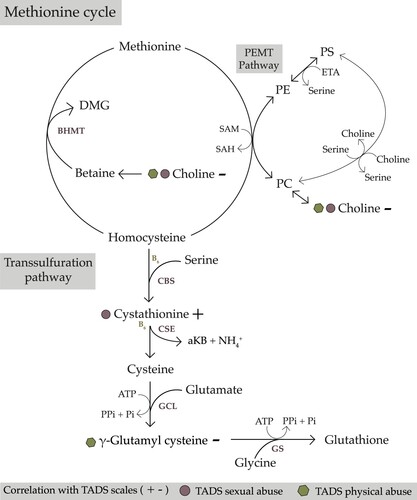Figures & data
Table 1. Characteristics of the participants with covariates in the multivariate models, and linear regression coefficients in models predicting Trauma and Distress Scale (TADS) Sexual Abuse and Physical Abuse factor scores.
Figure 1. Schematic illustration of metabolites correlating positively (+) or negatively (-) with the Trauma and Distress Scale (TADS) Sexual and Physical Abuse scores, and the related systems or mechanisms in which these metabolites are involved.

Figure 2. Illustration of the one-carbon metabolism methionine cycle, as well as the transsulfuration and phosphatidylethanolamine N-methyltransferase (PEMT) pathways. Round symbols represent the TADS Sexual Abuse scale, hexagons the TADS Physical Abuse scale, and + and – symbols represent the direction of correlation between the scale and the metabolite. aKB, α-ketobutyrate; ATP, adenosine triphosphate; BHMT, betaine-homocysteine S-methyltransferase; CBS, cystathionine β-synthase; CSE, cystathionine gamma-lyase; DMG, dimethylglycine; ETA, ethanolamine; GCL, glutamate-cysteine ligase; GS, glutathione synthetase; PC, phosphatidylcholine; PE, phosphatidylethanolamine; PEMT, phosphatidylethanolamine N-methyltransferase; Pi, phosphate; PPi, pyrophosphate; PS, phosphatidylserine; SAH, S-adenosylhomocysteine; SAM, S-adenosylmethionine.

Supplemental Material
Download MS Word (61.6 KB)Supplemental Material
Download MS Word (61.4 KB)Supplemental Material
Download MS Word (17.5 KB)Supplemental Material
Download MS Word (12.9 KB)Data availability statement
The data that support the findings of this study are available on request from the corresponding author, KK. The data are not publicly available due to their containing information that could compromise the privacy of research participants. The study plan approved by the ethical committee and the participant consent terms preclude public sharing of these sensitive data, even in anonymized form.
